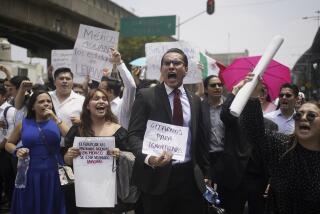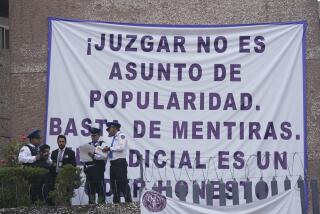The Party and the Power
- Share via
The Institutional Revolutionary Party (PRI), under various names, has dominated Mexican politics since 1929. * PHILOSOPHY: In theory, the party’s principles are those of the Mexican Revolution, including land reform, social welfarism, economic nationalism and an independent foreign policy. * ORGANIZATION: The party has three wings. The agrarian sector is mainly edjidatarios , or communal-farm peasants. The labor sector is dominated by urban workers in the Confederation of Mexican Workers (CTM). The popular sector includes professionals, small farm owners, small businesses, and civil servants.
HISTORY: 1928: Alvaro Obregon, Mexico’s last military caudillo , is assassinated. President Plutarco Elias Calles begins to organize a political party. * 1929: The Partido Nacional Revolucionario (PNR), or National Revolutionary party, is created in Queretaro as a coalition of several parties that backed the Mexican Revolution. * 1938: Party is renamed Partido de la Revolution Mexicana (PRM), or Party of the Mexican Revolution, and organized into four sectors: agrarian, labor, popular and military. The military sector is eliminated in 1940. * 1946: Party is renamed the Partido Revolucionario Institucional (PRI), or Instituional Revolutionary Party. * 1983: After decades of victories, the party suffers losses to opposition Partido Accion Nacional (PAN), or National Action party, in elections in state capitals of Durango and Chihuahua. * 1985: The PRI sweeps state governorships and Federal Chamber of Deputies seats amid charges of fraud. PAN supporters and police clash violently. * 1988: Dissident faction in the PRI, the Corriente Democratica (CD), forms an electorial alliance with a new left-wing coalition. Its presidential candidate, CD leader Cuauhtemoc Cardenas, loses to PRI’s Carlos Salinas de Gortari, amid widespread fraud charges. But for the first time, the PRI loses seats in the Senate. * 1989: The PRI loses elections in 52 of the 113 municipalities contested to the Partido de la Revolucion Democratica (PRD), composed of the CD and left-wing parties and led by Cardenas. The PRD, claiming it won 62, occupies contested town halls. * 1990-91: The PRI makes many gains in state, local and congressional elections as the government’s economic reforms prove popular. The PRD charges fraud, and newly elected PRI governors in Guanajuato and San Luis Potosi are eventually replaced with interim governors pending new elections. * 1992: The PRI wins most elections in 14 states, but PAN wins the governorship of Chihuahua. The PRI governor of Michoacan, whose election was disputed, temporarily resigns. * January, 1993: PRD supporters clash with security forces while protesting alleged PRI fraud in municipal elections in Michoacan and Oaxaca states. * November, 1993: Salinas appoints Luis Donaldo Colosio as the PRI candidate for elections in August, 1994. * March, 1994: Colosio is assassinated during a campaign rally in Tijuana. * ELECTION RECORD: The PRI’s margin of victory has declined in recent presidential elections. * Votes for PRI in presidential elections 1934: 98.2% 1940: 93.9 1946: 77.9 1952: 74.3 1958: 90.4 1964: 88.8 1970: 83.3 1976: 93.6 1982: 71.0 1988: 50.7 * In 1958-82, includes votes for two other parties that regularly endorsed the PRI’s candidate. In 1988, the parties backed opposition candidate Cuauhtemoc Cardenas. The PRI ran virtually unopposed because PAN opposition party failed to nominate a candidate. * SOURCES: Encyclopedia of Latin America; Latin American Political Dictionary; “The Mexican Political System in Transition” by Wayne A. Cornelius and Ann L. Craig; Europe World Yearbook, 1993
More to Read
Sign up for Essential California
The most important California stories and recommendations in your inbox every morning.
You may occasionally receive promotional content from the Los Angeles Times.













